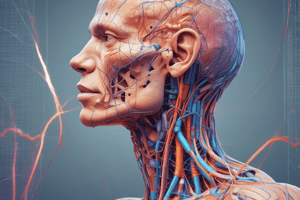Podcast
Questions and Answers
What is electromyography?
What is electromyography?
A diagnostic test that measures the electrical activity within muscle fibers in response to nerve stimulation.
What does electroneuromyography involve?
What does electroneuromyography involve?
Nerve conduction studies and diagnostic procedure for testing and recording neuromuscular activity.
What is an example of an antispasmodic?
What is an example of an antispasmodic?
- Aspirin
- Atropine (correct)
- Ibuprofen
- Morphine
What are skeletal muscle relaxants used for?
What are skeletal muscle relaxants used for?
What is the function of a neuromuscular blocker?
What is the function of a neuromuscular blocker?
What does occupational therapy aim to assist with?
What does occupational therapy aim to assist with?
What is myofascial release?
What is myofascial release?
What is the purpose of therapeutic ultrasound?
What is the purpose of therapeutic ultrasound?
What does RICE stand for?
What does RICE stand for?
What is a fasciotomy?
What is a fasciotomy?
What is tenodesis?
What is tenodesis?
What is a tenotomy?
What is a tenotomy?
Flashcards are hidden until you start studying
Study Notes
Diagnostics and Treatment Terminology
- Electromyography: A test that evaluates electrical activity in muscle fibers, triggered by nerve stimulation.
- Electroneuromyography: Involves nerve conduction studies, testing neuromuscular activity through electric stimulation of nerve trunks to identify nerve lesions or muscle pathologies.
Medications
- Antispasmodic: Anticholinergic agents that suppress smooth muscle contractions in the stomach, intestine, or bladder; atropine is commonly used preoperatively to relax these muscles.
- Skeletal muscle relaxant: Medication aimed at easing muscle stiffness, pain, and discomfort from strains and sprains; helps in recovery from injuries.
- Neuromuscular blocker: A drug that induces temporary paralysis by hindering nerve signal transmission to muscles; often used during surgery alongside anesthesia.
Therapeutic Approaches
- Occupational therapy: Focuses on assisting patients in recovering their ability to perform daily living activities through tailored therapeutic activities.
- Myofascial release: A specialized soft tissue manipulation technique designed to alleviate pain associated with conditions like fibromyalgia, myofascial pain syndrome, temporomandibular joint (TMJ) disorders, and carpal tunnel syndrome.
- Therapeutic ultrasound: Utilizes high-frequency sound waves to promote healing of muscle injuries by generating heat within the muscle tissue.
Injury Management Techniques
- RICE: An acronym for Rest, Ice, Compression, and Elevation; a standard method for managing acute injuries to reduce swelling and pain.
- Fasciotomy: A surgical procedure that involves creating an incision through the fascia to relieve tension or pressure, often necessary in cases of compartment syndrome.
Surgical Procedures
- Tenodesis: The surgical procedure where the end of a tendon is sutured to a bone, often performed to improve function after tendon injuries.
- Tenotomy: A surgery that involves the division of a tendon to correct deformities caused by the abnormal shortening of a muscle.
Studying That Suits You
Use AI to generate personalized quizzes and flashcards to suit your learning preferences.




